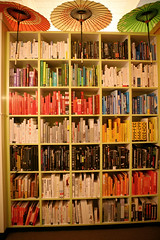With very small shifts, we can re-energize our classroom. Maybe the kind of examples we use in class might work, or the kind of activities we ask students to perform can be effective. However, a more ambitious, but rewarding change that focuses on uniqueness and design, can do wonders. How about going beyond Youtube low-quality videos and clipart and finding multimedia that inspires, instigates, that asks for action, resources that are appealing, daring? Yes, we can be designers of change that bring a bit of delight to our learning environment.
Daniel Pink, in his "A Whole New Mind" says, "We may not all be Dali or Degas. But today we must all be designers". We can be inspired and inspire our learners to appreciate their surrounding and to add uniqueness to their own ways of thinking and acting. This might be an ambitious dead, but, bit by bit, we can make a difference. Daniel Pink goes on saying that "good design offers us a chance to bring pleasure, meaning and beauty to our lives. But most important, cultivating a design sensibility can make our small planet a better place for us all".
Let me just give you a very simple practical example. In every school book, there's a topic related to cities or the place we live, right? Think of the last time you taught this lesson. How did you teach it? What resources did you use?
Here's one beautifully-produced short Brazilian video that can be used in the classroom to discuss the topic:
From there, some pedagogical ideas:
- Explore the concept of uniqueness in your city. What makes xxxxx unique?
- How can you make the ugly beautiful?
- Urban sprawl: You are the mayor of a big city. Traffic is chaotic, peoplre are stressed out. You don't have many resources, but there is a group of artists willing to change the lives of its inhabitants. What could they do to help you make life in the city more enjoyable?
- Use other city shorts videos and ask students to compare cities, to decide where they would live if they had the chance, for example. (Rotterdam, New York , Berlin, Istanbul, Seoul)
Remember: design in our lesson plans is two-fold (1) thinking of activities that are pedagogically-sound and follow a logical, contextualized sequence (2) finding resources that are visually-appealing and enhance meaningful interactions in the classroom.
We tend to focus on the first aspect, but forget how important it is for the eyes and the mind to enhance critical thinking, joy and change in the learning process.
Follow up:
Students check some multicultural projects http://multiculturaluniqueness.pbworks.com to get inspiration to produce their own digital artifact to answer the question: "What makes (their city) unique?"
Follow up:
Students check some multicultural projects http://multiculturaluniqueness.pbworks.com to get inspiration to produce their own digital artifact to answer the question: "What makes (their city) unique?"
"It's not true that what is useful is beautiful. It is what is beautiful that is useful. Beauty can improve people's way of life and thinking."
Anna Castelli Ferrieri, furniture designer


Inspiring, instigating, beautiful... Thanks for always sharing these wonderful ideas.
ReplyDelete